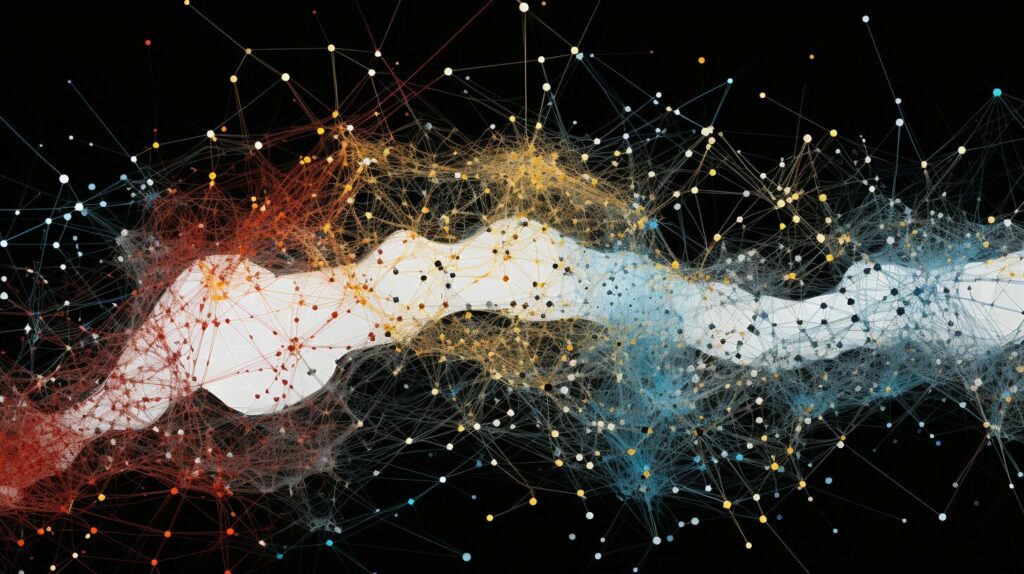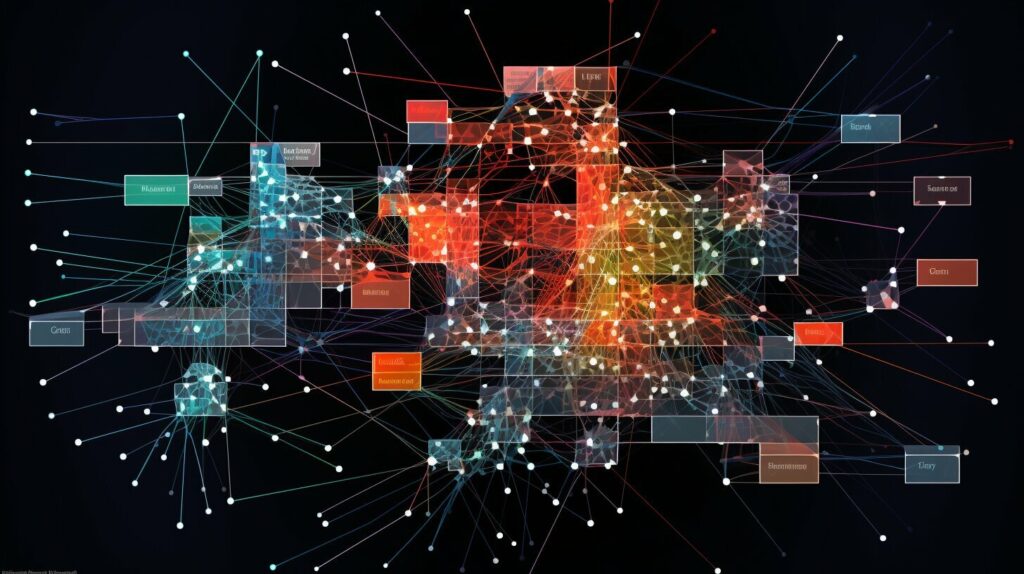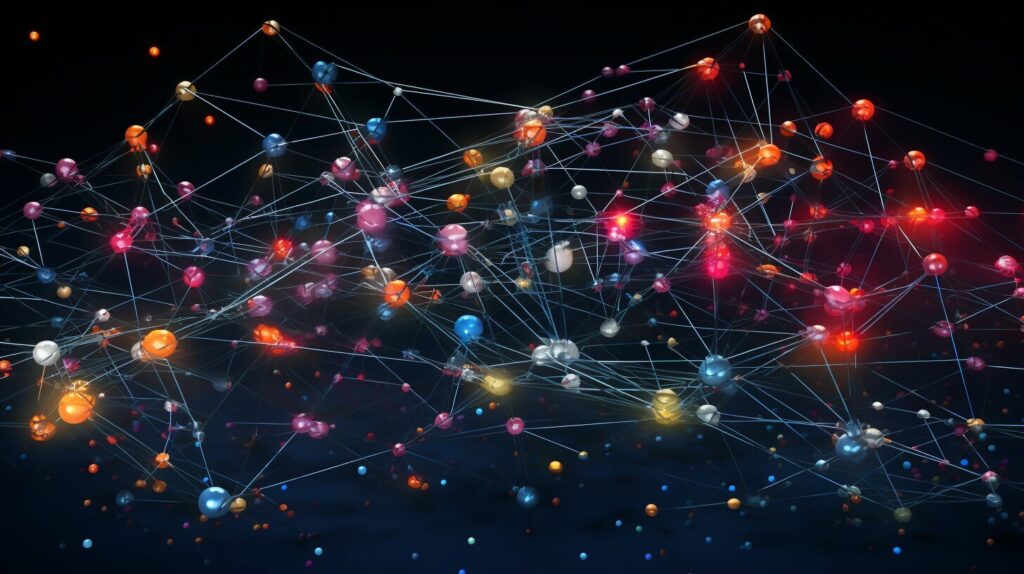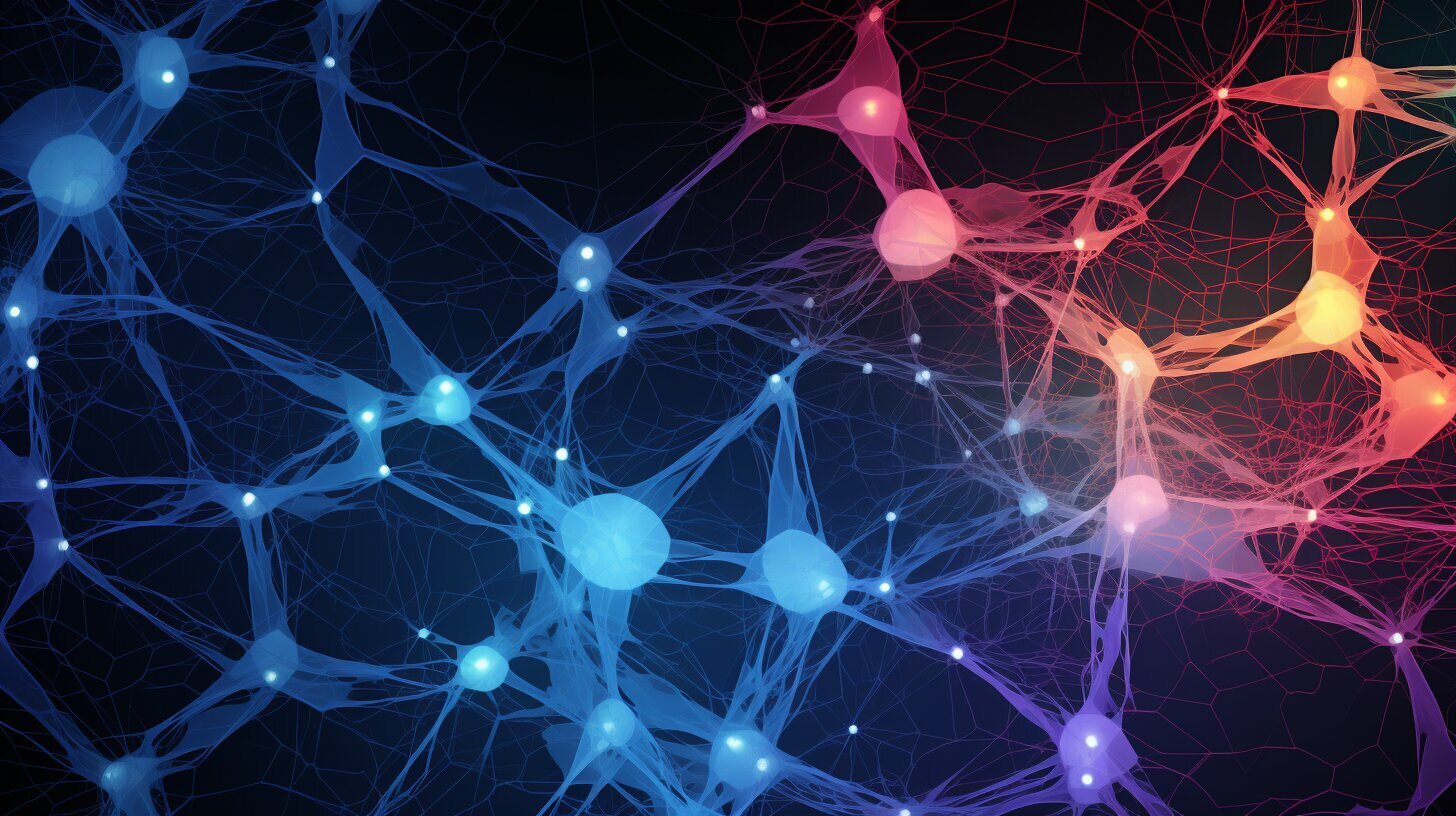Welcome to our comprehensive guide on neural networks, the core of artificial intelligence (AI) and the future of technology. This post will explore the fascinating world of neural networks, exploring how they impact deep learning and machine learning, as well as their applications in various fields such as pattern recognition, data analysis, and natural language processing.
Key Takeaways:
- Neural networks are computational models inspired by the human brain and are the foundation of AI.
- They consist of interconnected artificial neurons that process and transmit information.
- Neural networks can recognize patterns, make predictions, and solve complex problems in diverse domains.
- The structure of a neural network includes input layers, hidden layers, and an output layer, each performing specific computations.
- Training a neural network involves modifying link weights and biases to improve its performance.
- There are different types of neural networks designed for specific tasks, such as image recognition, natural language processing, and speech recognition.
- Neural networks offer advantages like managing complicated patterns, adaptability, parallel processing, and successful generalization of learned knowledge.
What is a Neural Network?
A neural network, also known as an artificial neural network (ANN) or simulated neural network (SNN), is a computational model inspired by the structure and functioning of the human brain. It is a fundamental component of machine learning and serves as the foundation for deep learning algorithms. Neural networks consist of interconnected nodes, known as artificial neurons, which process and transmit information.
By learning from data, neural networks can recognize patterns, make predictions, and solve complex problems. This ability makes them invaluable in various fields, including image recognition, natural language processing, speech recognition, medical diagnosis, self-driving cars, financial prediction, gaming, and fraud detection.
Neural networks simulate the way the human brain processes information, allowing them to tackle tasks that were previously challenging for traditional algorithms. Their interconnected structure and ability to learn from data make them highly adaptable and efficient at solving complex problems. Through their capacity to recognize patterns and make predictions, neural networks are revolutionizing artificial intelligence and shaping the future of technology.
| Advantages of Neural Networks: |
|---|
| Manage complicated patterns and nonlinear interactions |
| Adaptability and continuous learning |
| Parallel processing of massive amounts of data |
| Automatic feature extraction |
| Successful generalization from training to real-world scenarios |
“Neural networks excel at managing complicated patterns and nonlinear interactions that may be challenging for other algorithms.”
What makes neural networks so powerful?
- Neural networks can manage complicated patterns and nonlinear interactions, making them highly effective in solving complex problems that traditional algorithms may struggle with.
- They are adaptable and have the ability to continuously learn from new data, improving their performance over time.
- Neural networks can process massive amounts of data in parallel, providing faster and more efficient computing capabilities.
- With automatic feature extraction, neural networks eliminate the need for manual feature engineering, making them suitable for handling unstructured data.
- Neural networks have the capacity to generalize successfully from training data to real-world scenarios, allowing them to make accurate predictions and classifications in various applications.

Conclusion
Neural networks, as computational models inspired by the human brain, play a critical role in machine learning and the development of artificial intelligence. Their ability to recognize patterns, make predictions, and solve complex problems positions them as a cornerstone of modern technology. With ongoing advancements in interpretability, efficiency, and integration with emerging technologies, neural networks are poised to reshape various industries and drive innovation in the years to come.
The Structure of a Neural Network
A neural network is composed of interconnected artificial neurons arranged in layers. This structure allows the network to process and transmit information, enabling it to recognize patterns, make predictions, and solve complex problems. The structure of a neural network consists of three main types of layers: the input layer, hidden layers, and output layer.
The input layer is where the network receives data or input. Each input is connected to every neuron in the first hidden layer through weighted connections. These weighted connections determine the strength of the relationship between the inputs and the neurons in the hidden layers. The hidden layers perform mathematical operations on the inputs and pass the results to the next layer in the network. This process continues until the output layer, which provides the final predictions or outputs.
Activation functions play a crucial role in the structure of a neural network. They introduce non-linearities into the computations, allowing the network to model complex relationships between the inputs and outputs. Common activation functions include the sigmoid function and Rectified Linear Unit (ReLU). These functions determine the output of each neuron based on its inputs and determine whether it should “fire” or transmit information to the next layer.
| Layer | Description |
|---|---|
| Input Layer | Receives the data or input |
| Hidden Layers | Perform computations on the inputs and transmit the results |
| Output Layer | Provides the final predictions or outputs |
The structure of a neural network, with its interconnected artificial neurons, weighted connections, mathematical operations, and activation functions, allows it to process complex data and solve a wide range of problems in various fields.
Training a Neural Network
Training a neural network is a crucial step in harnessing its power and enabling it to make accurate predictions and classifications. During the training process, the network learns from data by iteratively modifying its link weights and biases, ultimately reducing the discrepancy between expected and actual outputs. This iterative process is known as backpropagation, and it relies on optimization algorithms to update the network’s parameters based on calculated gradients.
The modification of link weights and biases is essential for improving the network’s accuracy. By adjusting these values, the neural network can fine-tune its decision-making process, allowing it to better recognize patterns and make informed predictions. The training process can involve thousands or even millions of iterations, depending on the complexity of the problem and the size of the dataset.
Backpropagation and optimization algorithms play a vital role in training a neural network. Backpropagation calculates the gradients for each weight and bias, indicating how the modification of each parameter will affect the overall performance of the network. Optimization algorithms use these gradients to update the parameters and move the network towards better accuracy. Common optimization algorithms include stochastic gradient descent (SGD), Adam, and RMSprop.
Backpropagation and Optimization Algorithms
The backpropagation algorithm is the cornerstone of training neural networks. It works by propagating the error from the network’s output layer back to the input layer, adjusting the weights and biases along the way. This process allows the network to learn from its mistakes and make the necessary corrections to improve its predictions.
“Backpropagation is a key concept in training neural networks. By propagating the error backwards through the network, we can adjust the weights and biases to minimize the discrepancy between expected and actual outputs. This iterative process enables the network to learn and improve over time.”
Optimization algorithms, on the other hand, determine how the network’s parameters should be updated based on the calculated gradients. These algorithms consider factors such as learning rate, momentum, and regularization to ensure the network converges to an optimal solution. The choice of optimization algorithm can significantly impact the training process and the ultimate performance of the neural network.
| Optimization Algorithm | Description | Advantages |
|---|---|---|
| Stochastic Gradient Descent (SGD) | Updates the parameters after each sample or batch, making it computationally efficient. | – Simplicity and ease of implementation – Low memory requirements – Suitable for large datasets |
| Adam | Adaptive learning rate algorithm that combines the benefits of AdaGrad and RMSprop. | – Efficient handling of sparse gradients – Fast convergence – Robust performance across various datasets |
| RMSprop | Divides the learning rate by a running average of the magnitudes of previous gradients. | – Fast convergence – Ability to handle non-stationary objectives – Suitable for recurrent neural networks |
Choosing the right optimization algorithm depends on factors such as dataset size, problem complexity, and available computational resources. Each algorithm has its strengths and weaknesses, and experimentation is often necessary to determine the optimal choice for a specific neural network training task.

Types of Neural Network
Neural networks come in various types, each tailored for specific applications and challenges. Let’s explore some of the most common types:
Perceptron
The perceptron is the most basic architecture of a neural network. It is limited to binary classification tasks and consists of a single layer of artificial neurons. While simple in structure, perceptrons paved the way for more complex neural network models.
Feedforward Neural Network (FNN) or Multi-Layer Perceptrons (MLPs)
A feedforward neural network, also known as a multi-layer perceptron, is a widely used neural network architecture. Information flows in one direction, from the input layer to the output layer. FNNs are employed in various applications, including classification, speech recognition, and pattern recognition.
Convolutional Neural Network (CNN)
A convolutional neural network is designed for processing grid-like data, such as images. It employs convolutional layers to extract important features and hierarchical structures in the data. CNNs excel in image processing tasks like pattern recognition, machine translation, and computer vision.
Recurrent Neural Network (RNN)
A recurrent neural network is ideal for handling sequential data, where the order of information is crucial. RNNs capture temporal relationships and are commonly used in tasks such as text processing, text-to-speech conversion, image tagging, and future predictions.
Long Short-Term Memory (LSTM) Network
An LSTM network is a type of recurrent neural network that addresses the vanishing gradient problem and retains information over a longer period of time. LSTMs are widely used in applications such as gesture recognition, speech recognition, and text prediction.

These types of neural networks form the foundation of AI and enable machines to learn, recognize patterns, and make predictions. Each type has its strengths and is suited for different tasks and data types. By understanding the different architectures, we can leverage the power of neural networks to solve complex problems in various fields.
The Advantages of Neural Networks
Neural networks offer several key advantages that make them a powerful tool in various applications. One of the main strengths of neural networks is their ability to manage complicated patterns and nonlinear interactions, which can be challenging for other algorithms. By mimicking the structure and functioning of the human brain, neural networks excel at recognizing complex relationships and making accurate predictions.
Another advantage of neural networks is their adaptability and continuous learning capabilities. They can learn from new data and improve their performance over time, making them highly effective in dynamic and evolving environments. This adaptability allows neural networks to stay up-to-date with changing patterns and trends, ensuring their predictions and classifications remain accurate and relevant.
Neural networks also benefit from parallel processing, which enables them to handle massive amounts of data simultaneously. This parallelism leads to more efficient computing and faster training durations, making neural networks suitable for real-time applications and large-scale data analysis.
Another notable advantage of neural networks is their automatic feature extraction capability. Unlike traditional algorithms that require manual feature engineering, neural networks can automatically identify and extract relevant features from raw data. This eliminates the need for human intervention and streamlines the data preprocessing phase.

| Advantages | Description |
|---|---|
| Manage Complicated Patterns | Neural networks excel at recognizing and managing complex patterns and nonlinear interactions. |
| Adaptability and Continuous Learning | Neural networks can learn from new data and continuously improve their performance over time. |
| Parallel Processing | Neural networks can process massive amounts of data in parallel, enabling more efficient computing and faster training durations. |
| Automatic Feature Extraction | Neural networks can automatically extract relevant features from raw data, eliminating the need for manual feature engineering. |
Conclusion
In conclusion, the future of neural networks holds immense potential for innovation and transformation. As we continue to develop these powerful computational models, we can expect advancements in interpretability, efficiency, and integration with emerging technologies. This will drive new possibilities and shape various industries.
Neural networks are at the forefront of artificial intelligence, enabling breakthroughs in image recognition, natural language processing, and more. With their ability to learn from data and recognize complex patterns, they hold the key to achieving human-like intelligence in machines.
By enhancing interpretability, neural networks will provide a deeper understanding of how they reach their conclusions, making them more reliable and trustworthy. Additionally, improvements in efficiency will allow for faster computations and training, accelerating the development of AI applications.
Integration with emerging technologies will further expand the capabilities of neural networks, paving the way for exciting advancements in fields such as healthcare, robotics, and beyond. As these technologies continue to evolve, neural networks will reshape industries and unlock new possibilities for human progress.
FAQ
What is a neural network?
A neural network is a computational model inspired by the structure and functioning of the human brain. It is also known as an artificial neural network (ANN) or simulated neural network (SNN). Neural networks are essential components of machine learning and the foundation of deep learning algorithms.
How does a neural network work?
Neural networks consist of interconnected nodes, or artificial neurons, that process and transmit information. By learning from data, neural networks can recognize patterns, make predictions, and solve complex problems. They have applications in various fields, including image recognition, natural language processing, and speech recognition.
What is the structure of a neural network?
The structure of a neural network consists of layers of interconnected artificial neurons. These layers are divided into three types: the input layer, one or more hidden layers, and an output layer. The input layer receives data, which is processed through hidden layers using weighted connections. Each artificial neuron applies a mathematical operation on its inputs and passes the output to the next layer. The output layer provides the final predictions or outputs.
How is a neural network trained?
Training a neural network involves iteratively modifying the network’s link weights and biases to reduce the discrepancy between expected and actual outputs. This process, known as backpropagation, utilizes optimization algorithms to update the parameters based on calculated gradients. The network learns by continuously improving its ability to make accurate predictions through the training process.
What are the types of neural networks?
There are several types of neural networks based on specialized architectures and variations tailored for specific applications and challenges. The most common types include perceptron, feedforward neural network, convolutional neural network, recurrent neural network, and long short-term memory network.
What are the advantages of neural networks?
Neural networks excel at managing complicated patterns and nonlinear interactions that may be challenging for other algorithms. They have the ability to adapt and learn from new data, process massive amounts of data in parallel, automatically extract features, and successfully generalize from training data to unknown examples. These advantages make neural networks valuable tools in various applications.
What does the future hold for neural networks?
The future of neural networks holds tremendous potential, with advancements in interpretability, efficiency, and integration with emerging technologies expected to drive innovation. Neural networks are poised to enable machines with human-like intelligence and reshape various industries, from healthcare to robotics.









